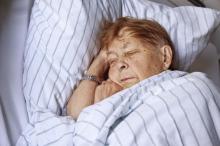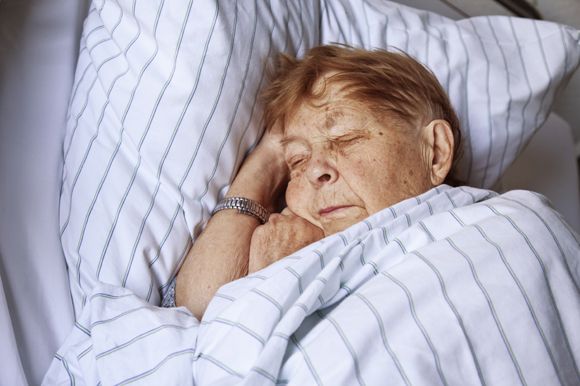User login
A treatment for narcolepsy reduced sleep problems in individuals with Parkinson’s disease who had excessive daytime sleepiness in a double-blind, randomized, placebo-controlled, phase 2a trial.
The trial results provide “class I evidence for the efficacy of sodium oxybate in treating sleep-wake disturbances in Parkinson’s disease. This finding is based on the extensive, electrophysiologically proven treatment effect that, to our knowledge, is unmatched by any other intervention reported so far,” Fabian Büchele, MD, of the department of neurology at University Hospital Zürich and his colleagues wrote in their report (JAMA Neurol. 2017 Nov 6. doi: 10.1001/jamaneurol.2017.3171).
“Sodium oxybate–related improvements of sleep and EDS [excessive daytime sleepiness] correlated significantly, whereas sodium oxybate–induced sleep disturbances predicted insufficient treatment response and AEs [adverse events],” they wrote.
The study of 12 patients used a crossover design to examine how well the sodium oxybate could improve sleep latency and scores on the Epworth Sleepiness Scale. The investigators randomized the patients to receive the central nervous system depressor sodium oxybate followed by placebo, or to placebo first and then the active drug, with a 2- to 4-week washout period in between crossovers. Sodium oxybate or placebo were taken at bedtime, and 2.5-4 hours later, with the dose individually titrated between 3 g and 9 g per night, for 6 weeks.
The treatment was associated with significant improvements, including a significant 2.9-minute increase in mean sleep latency on the intention-to-treat analysis (P = .002) and a 3.5-minute increase in the per-protocol analysis (P less than .001), as well as a 4.2-point reduction in Epworth Sleepiness Scale scores (P = .001).
Patients treated with sodium oxybate reported enhanced subjective sleep quality, shown as a 2-point mean reduction in Parkinson’s Disease Sleep Scale–2 scores and a 72.7-minute mean increase in slow-wave stage N3 sleep (and reduction in superficial stage N1 sleep).
In eight patients, there was at least a 50% clinically significant increase in mean sleep latency, and six patients had a normalization of Epworth Sleepiness Scale scores.
The sodium oxybate was fairly well tolerated, with no dropouts related to adverse events. All patients experienced adverse events, but three-quarters of these were described as not interfering with daily activities, and one-quarter as having a mild to moderate impact on daily activities. Most resolved after dose adjustment, but one-third of patients were still affected by the end of the study.
One patient dropped out during the washout phase and another was excluded from the per-protocol analysis; both of these patients developed sleep apnea during the course of the study. One patient also developed parasomnia during the study.
While the authors said that their results on efficacy and safety matched those found in trials of sodium oxybate for narcolepsy, their study was limited by small numbers, and larger follow-up trials of longer duration are needed to confirm the findings.
The study was funded by UCB Pharma, which provided the drug and placebo, and by the Clinical Research Priority Program Sleep and Health of the University of Zürich. Five authors declared speaker honoraria and grants from a range of organizations and pharmaceutical companies, including one author who had received these from UCB Pharma. No other conflicts were declared.
A treatment for narcolepsy reduced sleep problems in individuals with Parkinson’s disease who had excessive daytime sleepiness in a double-blind, randomized, placebo-controlled, phase 2a trial.
The trial results provide “class I evidence for the efficacy of sodium oxybate in treating sleep-wake disturbances in Parkinson’s disease. This finding is based on the extensive, electrophysiologically proven treatment effect that, to our knowledge, is unmatched by any other intervention reported so far,” Fabian Büchele, MD, of the department of neurology at University Hospital Zürich and his colleagues wrote in their report (JAMA Neurol. 2017 Nov 6. doi: 10.1001/jamaneurol.2017.3171).
“Sodium oxybate–related improvements of sleep and EDS [excessive daytime sleepiness] correlated significantly, whereas sodium oxybate–induced sleep disturbances predicted insufficient treatment response and AEs [adverse events],” they wrote.
The study of 12 patients used a crossover design to examine how well the sodium oxybate could improve sleep latency and scores on the Epworth Sleepiness Scale. The investigators randomized the patients to receive the central nervous system depressor sodium oxybate followed by placebo, or to placebo first and then the active drug, with a 2- to 4-week washout period in between crossovers. Sodium oxybate or placebo were taken at bedtime, and 2.5-4 hours later, with the dose individually titrated between 3 g and 9 g per night, for 6 weeks.
The treatment was associated with significant improvements, including a significant 2.9-minute increase in mean sleep latency on the intention-to-treat analysis (P = .002) and a 3.5-minute increase in the per-protocol analysis (P less than .001), as well as a 4.2-point reduction in Epworth Sleepiness Scale scores (P = .001).
Patients treated with sodium oxybate reported enhanced subjective sleep quality, shown as a 2-point mean reduction in Parkinson’s Disease Sleep Scale–2 scores and a 72.7-minute mean increase in slow-wave stage N3 sleep (and reduction in superficial stage N1 sleep).
In eight patients, there was at least a 50% clinically significant increase in mean sleep latency, and six patients had a normalization of Epworth Sleepiness Scale scores.
The sodium oxybate was fairly well tolerated, with no dropouts related to adverse events. All patients experienced adverse events, but three-quarters of these were described as not interfering with daily activities, and one-quarter as having a mild to moderate impact on daily activities. Most resolved after dose adjustment, but one-third of patients were still affected by the end of the study.
One patient dropped out during the washout phase and another was excluded from the per-protocol analysis; both of these patients developed sleep apnea during the course of the study. One patient also developed parasomnia during the study.
While the authors said that their results on efficacy and safety matched those found in trials of sodium oxybate for narcolepsy, their study was limited by small numbers, and larger follow-up trials of longer duration are needed to confirm the findings.
The study was funded by UCB Pharma, which provided the drug and placebo, and by the Clinical Research Priority Program Sleep and Health of the University of Zürich. Five authors declared speaker honoraria and grants from a range of organizations and pharmaceutical companies, including one author who had received these from UCB Pharma. No other conflicts were declared.
A treatment for narcolepsy reduced sleep problems in individuals with Parkinson’s disease who had excessive daytime sleepiness in a double-blind, randomized, placebo-controlled, phase 2a trial.
The trial results provide “class I evidence for the efficacy of sodium oxybate in treating sleep-wake disturbances in Parkinson’s disease. This finding is based on the extensive, electrophysiologically proven treatment effect that, to our knowledge, is unmatched by any other intervention reported so far,” Fabian Büchele, MD, of the department of neurology at University Hospital Zürich and his colleagues wrote in their report (JAMA Neurol. 2017 Nov 6. doi: 10.1001/jamaneurol.2017.3171).
“Sodium oxybate–related improvements of sleep and EDS [excessive daytime sleepiness] correlated significantly, whereas sodium oxybate–induced sleep disturbances predicted insufficient treatment response and AEs [adverse events],” they wrote.
The study of 12 patients used a crossover design to examine how well the sodium oxybate could improve sleep latency and scores on the Epworth Sleepiness Scale. The investigators randomized the patients to receive the central nervous system depressor sodium oxybate followed by placebo, or to placebo first and then the active drug, with a 2- to 4-week washout period in between crossovers. Sodium oxybate or placebo were taken at bedtime, and 2.5-4 hours later, with the dose individually titrated between 3 g and 9 g per night, for 6 weeks.
The treatment was associated with significant improvements, including a significant 2.9-minute increase in mean sleep latency on the intention-to-treat analysis (P = .002) and a 3.5-minute increase in the per-protocol analysis (P less than .001), as well as a 4.2-point reduction in Epworth Sleepiness Scale scores (P = .001).
Patients treated with sodium oxybate reported enhanced subjective sleep quality, shown as a 2-point mean reduction in Parkinson’s Disease Sleep Scale–2 scores and a 72.7-minute mean increase in slow-wave stage N3 sleep (and reduction in superficial stage N1 sleep).
In eight patients, there was at least a 50% clinically significant increase in mean sleep latency, and six patients had a normalization of Epworth Sleepiness Scale scores.
The sodium oxybate was fairly well tolerated, with no dropouts related to adverse events. All patients experienced adverse events, but three-quarters of these were described as not interfering with daily activities, and one-quarter as having a mild to moderate impact on daily activities. Most resolved after dose adjustment, but one-third of patients were still affected by the end of the study.
One patient dropped out during the washout phase and another was excluded from the per-protocol analysis; both of these patients developed sleep apnea during the course of the study. One patient also developed parasomnia during the study.
While the authors said that their results on efficacy and safety matched those found in trials of sodium oxybate for narcolepsy, their study was limited by small numbers, and larger follow-up trials of longer duration are needed to confirm the findings.
The study was funded by UCB Pharma, which provided the drug and placebo, and by the Clinical Research Priority Program Sleep and Health of the University of Zürich. Five authors declared speaker honoraria and grants from a range of organizations and pharmaceutical companies, including one author who had received these from UCB Pharma. No other conflicts were declared.
FROM JAMA NEUROLOGY
Key clinical point: Sodium oxybate may reduce sleep-wake disturbances of Parkinson’s disease.
Major finding:
Data source: Randomized, placebo-controlled, crossover phase 2a trial in 12 patients with Parkinson’s disease.
Disclosures: The study was funded by UCB Pharma, which provided the drug and placebo, and by the Clinical Research Priority Program Sleep and Health of the University of Zürich. Five authors declared speaker honoraria and grants from a range of organizations and pharmaceutical companies, including one author who had received these from UCB Pharma. No other conflicts were declared.

